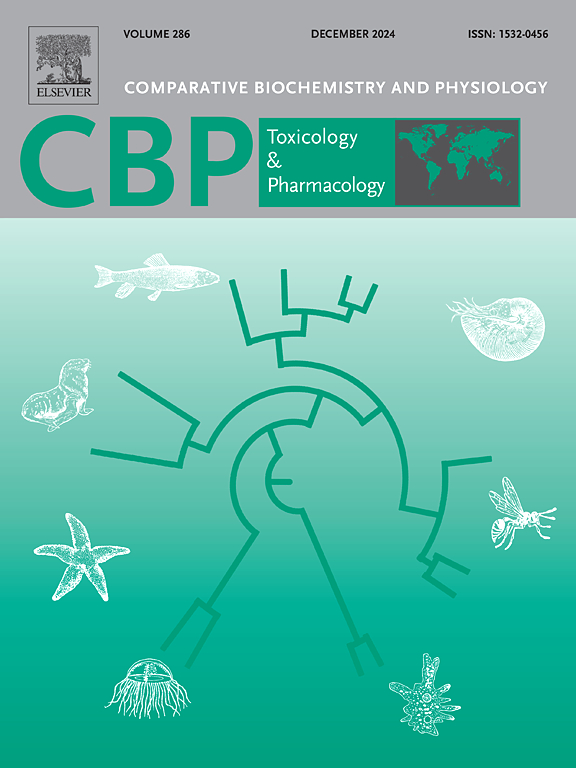Polystyrene nanoplastics cause developmental abnormalities, oxidative damage and immune toxicity in early zebrafish development
IF 3.9
3区 环境科学与生态学
Q2 BIOCHEMISTRY & MOLECULAR BIOLOGY
Comparative Biochemistry and Physiology C-toxicology & Pharmacology
Pub Date : 2025-05-06
DOI:10.1016/j.cbpc.2025.110216
引用次数: 0
Abstract
Aquatic organisms are increasingly affected by polystyrene nanoplastics (PSNPs), which have the potential to disrupt development, induce oxidative stress, and impair immune function. This study examined the effects of PSNPs on zebrafish (Danio rerio) embryos exposed to 0.01, 0.1, 1, and 10 μg/mL from 2 to 120 h post-fertilization (hpf). The findings indicated that developmental abnormalities occurred in a dose-dependent manner, including delayed hatching, decreased survival rates, reduced body length, smaller eye diameter, and enlarged yolk sac area. PSNPs accumulated in the chorion and yolk sac as early as 6 hpf and were detected in vital tissues, such as the eyes, heart, yolk sac, liver, pancreas, intestine, neuromasts, and tail, immediately after hatching. By 120 hpf, PSNPs significantly reduced swimming distance and velocity. Exposure to PSNPs induced oxidative damage evidenced by altered expression of antioxidant-related genes (CAT1, GPX1A, SOD1, NRF2, KEAP1, HSP70, MT), disrupting cellular homeostasis and causing structural and organ defects. Immune toxicity was marked by dysregulated expression of immune-related genes (IL-1β, IL-6, NF-κB, TNF-α, C3B, TLR-1, TLR-3, TLR-4), indicating inflammation and innate immune activation triggered by oxidative damage. This study highlights the interconnected impacts of developmental abnormalities, oxidative damage, and immune toxicity caused by PSNPs exposure, highlighting the systemic impacts of nanoplastics contamination in aquatic environments.

聚苯乙烯纳米塑料导致斑马鱼早期发育异常、氧化损伤和免疫毒性
聚苯乙烯纳米塑料(PSNPs)对水生生物的影响越来越大,它有可能破坏发育、诱导氧化应激和损害免疫功能。本研究考察了psnp对斑马鱼受精后2 ~ 120h分别暴露于0.01、0.1、1和10 μg/mL环境中的胚胎的影响。结果表明,雏鸡发育异常呈剂量依赖性,包括孵化延迟、存活率下降、体长缩短、眼直径变小、卵黄囊面积增大等。早在6 hpf时,psnp就在绒毛膜和卵黄囊中积累,并在孵化后立即在眼睛、心脏、卵黄囊、肝脏、胰腺、肠、神经鞘和尾巴等重要组织中检测到。在120 hpf时,psnp显著降低游泳距离和游泳速度。暴露于PSNPs诱导氧化损伤,其证据是抗氧化相关基因(CAT1、GPX1A、SOD1、NRF2、KEAP1、HSP70、MT)的表达改变,破坏细胞稳态并导致结构和器官缺陷。免疫毒性表现为免疫相关基因(IL-1β、IL-6、NF-κB、TNF-α、C3B、TLR-1、TLR-3、TLR-4)表达异常,表明氧化损伤引发炎症和先天免疫激活。本研究强调了PSNPs暴露引起的发育异常、氧化损伤和免疫毒性的相互影响,强调了水生环境中纳米塑料污染的系统性影响。
本文章由计算机程序翻译,如有差异,请以英文原文为准。
求助全文
约1分钟内获得全文
求助全文
来源期刊
CiteScore
7.50
自引率
5.10%
发文量
206
审稿时长
30 days
期刊介绍:
Part C: Toxicology and Pharmacology. This journal is concerned with chemical and drug action at different levels of organization, biotransformation of xenobiotics, mechanisms of toxicity, including reactive oxygen species and carcinogenesis, endocrine disruptors, natural products chemistry, and signal transduction with a molecular approach to these fields.

 求助内容:
求助内容: 应助结果提醒方式:
应助结果提醒方式:


